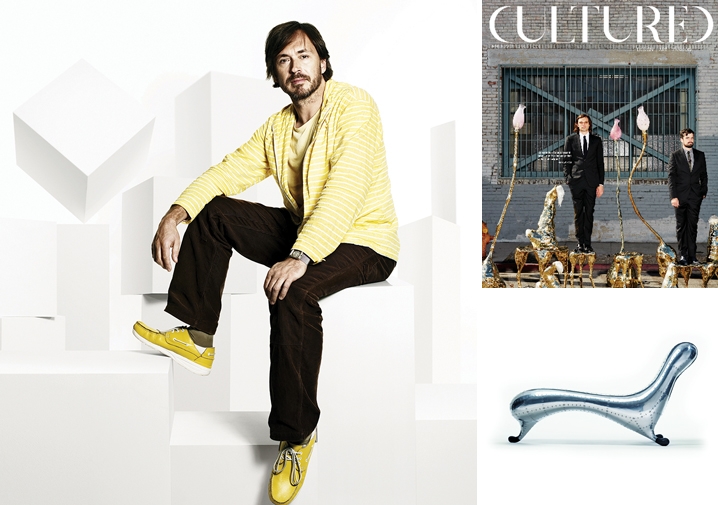Although he’s perhaps best known for his Lockheed Lounge, there’s hardly an object or industry Marc Newson hasn’t designed.
It seems that we are in a new age, where design objects are no longer being showcased on pedestals, platforms and cases, but rather in settings that emulate private homes. This new mode can be seen in furniture and tabletop shops, in galleries, real estate ventures and, now, in a show recently opened at the Philadelphia Museum of Art. Entitled “Marc Newson: At Home,” this first solo museum exhibition in the U.S. devoted to the Australian-born, London-based star-designer, is set up as a private residence. “The idea of displaying all products in a private home comes from our exhibition designer,” explains Kathryn B. Hiesinger, curator of European decorative arts. “It is a more interesting way to show design, but the whole show has been a joint effort with Marc Newson’s office.”
On view through April 20, this retrospective was opened in conjunction with the 2013 Design Excellence Award, given to Newson by Collab, a group of design enthusiasts who support modern and contemporary design acquisitions, exhibitions and education programming at the museum. The list of past recipients includes such legends as Michael Graves, Milton Glaser, George Nakashima, Frank Gehry, Karim Rashid, Florence Knoll Bassett and Philippe Starck. To Marc Newson, this award means entering one more design pantheon.
All objects in the show, including furniture in limited-edition, mass-produced furniture, household objects, tabletops, clothing, appliances and transportation, are displayed in a six-room residence, constructed for this occasion within the museum’s galleries. It’s a house without a roof or exterior walls, but with adult and children’s bedrooms, living room, kitchen, bathroom and garage, all furnished with pieces that Marc Newson has designed throughout his nearly three-decade career (and on loan for the show from the designer’s private collection, as well as from other collections across the globe).
Newson came to fame with one seat, the Lockheed Lounge. He designed this remarkable piece as a student in Sydney in the ‘80s and made history. The sculptural lounge chair, which manifests a futuristic aesthetic, is loosely based on 18th century chaises longues. It was featured in Madonna’s 1993 video for “Rain” and still captures the imaginations of design lovers worldwide. Named after the aerospace company, it’s displayed in the living room area of the exhibition, which represents Newson’s innovations and his vision of minimalist streamlining. Also included in the living room is Newson’s Pod of Drawers, another early piece that he designed in the ‘80s, which, like the Lockheed, is constructed of a fiberglass body clad with aluminum panels and shown along with the marble Voronoi low shelf from a later phase in Newson’s career, when his work was first represented by Gagosian Gallery in 2007. Together with other limited-edition pieces of marble, it was a part of a seminal show that marked the beginning of a relationship with the designer.
From the elegant living room, the viewer moves to the kitchen, which provokes a wholly different atmosphere, presenting a dynamic body of disciplines, from appliances, tableware, pots and pans, glassware, cutlery and a dish rack to a gas stove and oven topped by a stainless steel range hood; the dinnerware he designed for Qantas airlines is included as well. Then there is the children’s bedroom, with the whimsical Embryo chair, a modular Bunky bunk bed and the Rocky rocking horse; a bathroom furnished with sinks, showers, toilet, wall basin and hair appliances created for Vidal Sassoon; and finally the garage, housing the 021C, an eco-friendly concept car Newson designed for Ford, unveiled at the 1999 Tokyo Motor Show and described by him as “naïve.”
“You can fill out an entire house with everyday objects Newson designed,” says Hiesinger. In fact, his work touches so many territories that The New York Times published an article in 2012 entitled “Is There Anything Marc Newson Hasn’t Designed?” He’s always pushing boundaries, always fusing functionality with sleek aesthetics and always driven by a passion for innovation—a passion that is present everywhere throughout the fictional house presented at the Philadelphia Museum of Art. This intriguing show tells the story of one of the world’s most influential designers, but it also tells an important story of design, which is omnipresent these days and makes our lives so much more beautiful.
Portrait by Simon Upton



